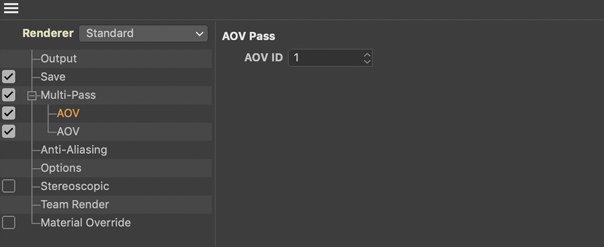AOV
With the introduction of Cinema 4D R21, Multi-Passes have been replaced by Arbitrary Ouput Variables (AOV). AOVs are in principle nothing other than the color that an individual node - or group node - outputs. In other words: The Solo functionality as a separate pass. Since the term node was just mentioned: the AOV functionality is restricted to Node Materials (and currently also only to the Node Materials of the Standard and Physical Renderers).
AOV passes make it possible to complete complex compositing tasks with the respective applications outside of Cinema 4D. Just about anything is possible since almost every Node can be output - in as far as it outputs a color or can be converted to a color.
How can Cinema 4D output AOV passes?
The following setting can be found in the respective Node Material’s ( e.g., Material Node) Input tab (AOV Multi-Passes sub-tab):

Here you can create any number of AOV IDs (same as AOV input ports). You can in turn connect any node output ports to these input ports. Click on Add to Render Settings to create suitable, separate AOV multi-passes:

AOV passes can also be created manually in the Render Settings by clicking on the Multi-Pass/AOV button. All you have to do then is define a suitable AOV ID (i.e., the one defined in the Node Material).
This is the result:
 In individual or goup nodes, one AOV pass is linked per output that can be output or saved as a multi-pass during rendering. The Group Node has about 20 individual Nodes whose Result culminates in an AOV pass. The Blend Node, for example, supplies the input for the Bump Map Node and is output at the top as AOV 2 in a multi-pass.
In individual or goup nodes, one AOV pass is linked per output that can be output or saved as a multi-pass during rendering. The Group Node has about 20 individual Nodes whose Result culminates in an AOV pass. The Blend Node, for example, supplies the input for the Bump Map Node and is output at the top as AOV 2 in a multi-pass.